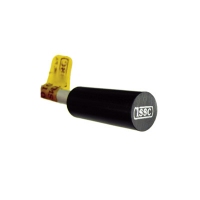
Model TMS-D
| Voltage | 9 to 26 VDC,10% ripple allowed |
ISSC Kanson Electronics magnetic proximity sensors use a physical property known as the Hall effect. When a thin sheet of a semiconductor material (a Hall element) is placed in a magnetic field and a perpendicular current is passed through it, a voltage is generated between the opposite borders of the semiconductor sheet.
The sensor is housed in a three branch slot case; the first branch contains the Hall element; the second brand contains the magnet; and the third brand contains a ferromagnetic vane that blocks the influence of the Hall element’s magnetic field to control output change.
Magnetic sensors are commonly used in automobile compasses, GPS navigation systems and dead reckoning modules.
Casings for Magnetic Effect Electronic Proximity Sensors consist of heavy duty plastic reinforced with glass fibers.

| Voltage | 9 to 26 VDC,10% ripple allowed |